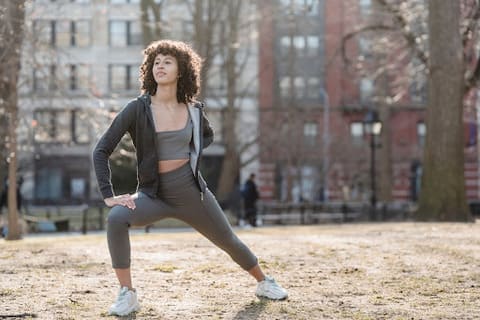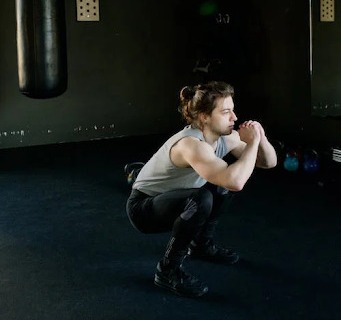Biking is an activity that’s not only good for you but also for the environment. You can cater to your wanderlust leisurely or train hard and achieve the goals you set for yourself. Bike alone or do it with your pack; it’s still exhilarating and fun.
Your arrival on this post is evidence of your attraction to biking. The reason behind looking up this topic may be a passion for biking or the desire to avail of its numerous benefits.

Biking can help build endurance, increase stamina, improve balance, and reduce stress, anxiety, and depression. Along with your health benefits, biking offers several benefits to the environment.
Like any other activity, if you are just getting started with biking, you need to start small and progress gradually. You need to prepare your body for optimal performance.
Issues That Result From Insufficient or Improper Body Preparation
Even though biking is a low-impact exercise, doing it repetitively for prolonged periods without appropriate body preparation can lead to injuries. The common problems that bikers face include but are not limited to the following:
- Knee issues like patella maltracking
- Back pain
- Carpal Tunnel Syndrome
- Shoulder aches
- Foot and ankle pain
- Numbness
- Urethra stricture
- Saddle sores
- Prostatitis
With adequate body preparation, you can avoid these and many such injuries.
Nutrition for Preparing the Body for Biking
To consciously condition your body for biking, you must pay close attention to your diet. When you start training, you will increase your caloric expenditure per week. Boost your nutrition intake to meet your needs. You must avoid increasing your caloric intake too much when you start training.
These basic nutrition guidelines will help you get started:
- Carbohydrates are the primary energy source during cycling. Human bodies can hold enough fuel in the form of glycogen for around 90 minutes of exercise. Try to consume 30g to 60g of carbohydrates per hour (adjust for the intensity of your session). Sufficient amounts of carbohydrates will help you avoid bonking.
- Protein is necessary for recovery after biking. If you don’t consume sufficient protein, you won’t see the full results of your efforts, and developing leg muscles will prove harder. Consume between 1.2 to 2.2 grams of protein per kilogram of body weight. Adopt the higher end of this scale if you train hard.
- Vitamin D is essential for developing stronger muscles and bones. It also helps boost metabolism and contributes to faster recovery times. You will get most of it from the sun. If you intend to take supplements, getting your physician’s opinion before starting on them would be a good idea.
- Vitamin C helps to have healthy skin, blood vessels, and bones. It also helps in quick recovery from wounds. Supplements can be added to your diet; 500mg daily should be sufficient.
- Men and women require about 320 mg and 420 mg of magnesium daily, so since you will be exercising hard, you should consider taking a magnesium supplement to prevent deficiency.
- Iron is essential if you exercise vigorously since it aids in developing and maintaining your body’s red blood cells and maximizes their capacity to carry oxygen to your muscles. A deficiency of iron will make you lethargic and weak. This will undoubtedly have a negative and significant impact on your biking. If you’re training hard, boosting your daily iron consumption is a good idea.
- Vitamin E protects the cells in your muscles and lungs (both of which are crucial for bikers). This vitamin is primarily found in fatty foods like oil and nuts.
Before biking, eat foods that are healthy sources of protein and carbs.
Fruit juice mixed with water is a fantastic method to stay hydrated, and the fructose in the juice will help meet your carb demands.
You could have scrambled eggs or plain yogurt to meet your protein requirements. These will work best with slow-release carbohydrates like oatmeal and whole-wheat toast.
Biking performance suffers when our bodies run out of energy. Use various suitable fueling techniques during your training to gain the maximum benefit out of what you put into your body. Establish healthy eating habits. Find a nutrition plan that works for you by listening to your body.
Hydration
You know hydration is essential, and the recommendation is 8 glasses daily. While that’s a good start, the requirements don’t remain the same for everyone. Hydration requirements vary because of factors such as gender and activity levels.
The intensity of your biking training will affect how much hydration you require. A highly intense training session would mean more fluid loss through sweating and a greater need for hydration.

Your body works better when you are well-hydrated and it helps control your body temperature. Hydration also guards tissues and lubricates your joints, affecting your cycling performance.
Drink about 1.5 cups of water four hours before you start your training session and 2 cups (total 500ml) of water 2 hours prior. During the biking session, you’ll need to amp up your hydration to match the amount of fluid you lose due to perspiration.
Bear in mind overhydration can lead to Exertional Hyponatremia. Develop an intelligent hydration plan based on your sweat rate.
The American College of Sports Medicine advises consuming 400–800 ml of fluid each hour while exercising endurance.
Water is usually sufficient for fulfilling hydration requirements.
However, an electrolyte drink is better if you are sweating a lot especially on a long and strenuous ride or during sweltering weather.
You can add some sodium to your water. Make a natural homemade electrolyte drink or use a medical-grade readymade version.
A Suitable Training Schedule
The value of a good training program cannot be emphasized enough. A good schedule helps riders to progress to greater distances and higher intensities and incorporates sufficient rest time between rides. It helps in avoiding overtraining or undertraining.
Your body needs time to adjust to the strain of exercise. You could get injured or face burnout if you jump right into long-distance biking instead of easing into it over time. An effective training schedule can:
- Build up your stamina
- Improve your fitness level over time
- Motivate you to progress toward your goals.
By conditioning your body, a good training schedule will also help improve your performance,take your biking skills to the next level, and get the most out of your biking experience.
To develop a suitable training schedule, enlist the help of a coach. Your coach will also be able to guide you on modifying the plan to suit the changing fitness levels of your body.
Stretching
Some bikers vouch for stretching before and after riding, while others don’t perceive much advantage. It depends on your preference.

However, dynamic stretching can relieve discomfort and reduce injury chances. Dynamic stretching before a biking session can be beneficial since it can prepare your body for the required movement.
Dynamic stretches are ideal pre-ride rituals because they include movement; You stretch your muscles while warming them up.
Static stretches are not advisable before exercise. You could get injured if your muscles are not warmed up. Static stretches are best done just after your biking session.
Body Conditioning Through Exercise
Having strong legs is essential for cycling. They produce more power and experience fatigue at a slower rate. Leg strengthening can help you achieve your biking goals easily.
Legs with more muscle will show more resilience during intense and long biking sessions. You can do additional leg exercises off the bike to strengthen your muscles. Exercising will help increase flexibility and boost riding performance.
Typically bikers will have slender, sculpted, but not very large legs. The bike is propelled by your leg muscles, which get more developed with your pedal strokes in the time you spend training.
However, biking’s low-impact, aerobic nature, although beneficial for your cardiovascular system, does not help much in building muscle mass in your legs.

You’ll need to train in the gym to increase muscle mass and consume a lot of protein. Try different types of squats (there’s even a cyclist squat) and lunges.
Some other exercises you can try are prowler push, barbell hip thrust, Romanian deadlift, and Nordic hamstring curl.
Note: Keeping your time on the bike to a minimum is crucial if you’re cycling on the same day as your leg workout. Alternatively, you can lengthen your duration on the bike if you cycle the day after a leg workout rather than immediately afterward.
Aerobic exercise like cycling is helpful for DOMS prevention and muscle recovery after a leg workout.
Contrary to common assumptions, biking won’t wear down your muscles; instead, it will condition your muscles to recover faster, even though it may feel challenging after lifting weights with your legs.
Sufficient Rest
You need to balance training with sufficient rest to advance your biking ability.
You will impede your progress if you exert too much on the training side and don’t allow adequate time to recuperate. Reduced performance, exhaustion, irritation, lack of enthusiasm, and frequent minor ailments indicate you are not getting enough rest.
While the amount of rest you require will vary, correctly incorporating rest days into your training can benefit your physical and mental health.
Your muscles get micro tears when you exercise, especially your quadriceps and glutes, during a strenuous session.
Allow these tears to heal by taking sufficient rest. It will help the muscle fibers get stronger and prevent an inflammatory response to any muscle and joint strains.
Biking Fitness for Beginners at Home
For those who want to pursue biking fitness without leaving the comfort of your home, investing in a good exercise bike like the Lanos Folding Exercise Bike can make all the difference.
Exercise bikes offer a fantastic way to get a vigorous cardio workout, helping you build your stamina and tone your lower body, especially your quadriceps, hamstrings, and calves.
For beginners, it’s an excellent way to ease into the world of fitness as it allows you to control your pace and resistance level, avoiding the risk of overexertion.
Advice for Riders of Folding Bikes
You probably love how your bike folds and its numerous benefits.
But are folding bikes good for exercise? Absolutely! And here are some tips to get the most out of a workout on your folding bike.
The folding action is straightforward to master. Although your dealer might have demonstrated how it works, practicing a little at home is worthwhile to truly grasp it.
Soon you will be able to sort out the fold very quickly. Get your body accustomed to the motion of folding the bike.
Use a track or hand pump to fill your tires up to 90 PSI once a week. Deflated tires can make your ride quite tiring. Take care of your bike to eliminate the chances of unnecessary strain on your body.
The brakes and chain of your bike will function smoothly if you regularly clean and remove the grime and grit from it. The area around the rear wheel deserves special attention.
Check the saddle position. Because every person’s physique is different, the standard saddle position is not suitable for everyone. It could make you feel stretched out or bunched up while riding.
For your comfort, shift the saddle forward or backward. Enlist the help of your local dealer if you need help making this adjustment. Such adjustments also help in taking care of your body.
Wrapping Up
Biking is about more than just getting the gear and mounting the bike. It’s also about care routines for your body and your bike before riding, during the ride, and after it. Preparing your body entails taking care of nutrition and hydration, exercising, training correctly, and resting sufficiently.
This quote by Robin Williams aptly describes the biking experience: “Riding a bicycle is the closest you can get to flying.” If you want to cross the horizon and scale new heights, you must prepare your body for it.

![Lanos Folding Exercise Bike Review [year] – Is It Any Good?](https://www.foldingbikeguy.com/wp-content/uploads/2022/05/Lanos-Folding-Exercise-Bike.jpg)

